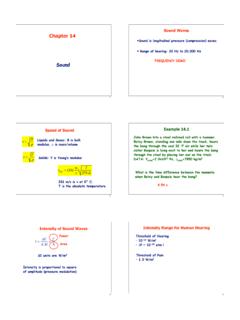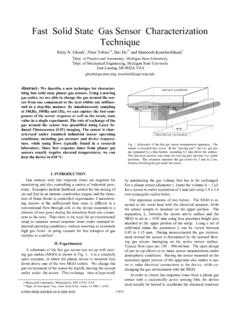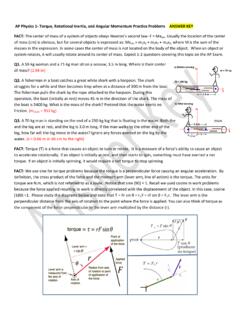Transcription of Experiment 5 Elastic and Inelastic Collisions
1 PHY191 Experiment 5: Elastic and Inelastic Collisions 7/12/2011 Page 1 Experiment 5 Elastic and Inelastic Collisions Reading: Bauer&Westfall: Chapter 7 (and 8, for center of mass ideas) as needed Homework 5: turn in the second week of this Experiment . Assume random and independent errors, and use v = L / t p = m v mpK22 measured: L = 2 .06 t = 1 .04 m = 2 .0001 (negligible uncertainty) For each question below, give the algebraic formula, then evaluate the numerical uncertainty in value and in % ( find K, then K/K in %): 1. Calculate the uncertainty in v in terms of the uncertainty in L and in t. 2. Calculate the uncertainty of p in terms of the uncertainty of v. 3. Calculate the uncertainty of K in terms of the uncertainty of p.
2 1. Goals 1. Study momentum and energy conservation in Inelastic and Elastic Collisions 2. Understand use of Excel in analyzing data 3. Carry out uncertainty calculations of moderate complexity 2. Theoretical Introduction The following Experiment explores the conservation of momentum and energy in a closed physical system (ideally: no interaction of measured objects with rest of universe). As you probably know from the accompanying theoretical course, the conservation of energy and momentum play an important role in physics and their conservation is a consequence of fundamental symmetries of nature. momentum For a single particle (or a very small physical object), momentum is defined as the product of the mass of the particle and its velocity: vmp (1) momentum is a vector quantity, making its direction a necessary part of the data.
3 To define the momentum in our three-dimensional space completely, one needs to specify its three components in x, y and z direction. The momentum of a system of more than one particle is the vector sum of the individual momenta: 221121vmvmppp (2) PHY191 Experiment 5: Elastic and Inelastic Collisions 7/12/2011 Page 2 The 2nd Newton s law of mechanics can be written in a form which states that the rate of the change of the system s momentum with time is equal to the sum of the external forces acting on this system: Fdtpd (3) From here we can immediately see that when the system is closed (which means that the net external force acting on the system is zero), the total momentum of the system is conserved (constant).
4 Energy Another important quantity describing the evolution of the system is its energy. The total energy of a given system is generally the sum of several different forms of energy. Kinetic energy is the form associated with motion, and for a single particle: 22mvKE (4) Here v without the vector symbol stands for the absolute value of the velocity, 222zyxvvv In contrast to momentum , kinetic energy is NOT a vector; for a system of more than one particle the total kinetic energy is the algebraic sum of the individual kinetic energies of each particle: 21 KEKEKE (5) Another fundamental law of physics is that the total energy of a system is always conserved. However within a given system, one form of energy may be converted to another (such as potential energy converted to kinetic in the Pendulum Experiment ).
5 Therefore, kinetic energy alone is often not conserved. Collisions An important area of application of the conservation laws is the study of the Collisions of various physical bodies. In many cases, it is hard to assess how exactly the colliding bodies interact with each other. However, in a closed system, the conservation laws often allow one to obtain the information about many important properties of the collision without going into the complicated details of the collision dynamics. In this lab, we will see in practice how the conservation of momentum and total energy relate various parameters (masses, velocities) of the system independently of the nature of the interaction between the colliding bodies. Assume we have two particles with masses 21,mm and speeds iv1 and iv2 which collide, without any external force, resulting in speeds of fv1 and fv2 after the collision ( i and f stand for initial and final).
6 Conservation of momentum then states that the total momentum before the collision iP is equal to the total momentum after the collisionfP : fffiiivmvmPvmvmP22112211, and fiPP (6) PHY191 Experiment 5: Elastic and Inelastic Collisions 7/12/2011 Page 3 Elastic and Inelastic Collisions There are two basic kinds of Collisions , Elastic and Inelastic : In an Elastic collision , two or more bodies come together, collide, and then move apart again with no loss in total kinetic energy. An example would be two identical "superballs", colliding and then rebounding off each other with the same speeds they had before the collision . Given the above example conservation of kinetic energy then implies: 22221122221121212121ffiivmvmvmvm or fiKEKE (7) In an Inelastic collision , the bodies collide and (possibly) come apart again, but now some kinetic energy is lost (converted to some other form of energy).
7 An example would be the collision between a baseball and a bat. If the bodies collide and stick together, the collision is called completely Inelastic . In this case, all of the kinetic energy relative to the center of mass of the whole system is lost in the collision (converted to other forms). In this Experiment you will be dealing with a) a completely Inelastic collision in which all kinetic energy relative to the center of mass of the system is lost, but momentum is still conserved, and b) a nearly Elastic collision in which both momentum and kinetic energy are conserved to within a few percent. Conservation laws for macroscopic bodies So far we were talking about the system of point-like particles. However, the conservation of the momentum is also valid for macroscopic objects.
8 This is because the motion of any macroscopic object can be decomposed into the motion of its center of mass (which is a point in space) with a given linear momentum , and a rotation of the object around this center of mass. Then, the conservation of the linear momentum is again valid for the motion of ideal point masses located at the center of the mass of each of the objects. However, some of the linear kinetic energy can be transformed into the rotational energy of the objects, which should be accounted for in a real Experiment . Kinetic Energy in Inelastic Collisions . It is possible to calculate the percentage of the kinetic energy lost in a completely Inelastic collision ; you will find that this percentage depends only on the masses of the carts used in the collision , if one of the carts starts from rest.
9 After the completely Inelastic collision , the carts move together, so that 321vvvff The initial KE is given by: 22221211iiivmvmKE . But, since 02 iv 2211iivmKE (8) The final KE is given by: 22123mmvKEf (9) PHY191 Experiment 5: Elastic and Inelastic Collisions 7/12/2011 Page 4 From conservation of momentum : 3212211)(vmmvmvmii or, since 02 iv 32111)(vmmvmi (10) Since the collision is Inelastic , the initial KE is not equal to the final KE. You could use equations (8), (9), and (10) to obtain an expression foriifKKEKEKED)((%) . Hint: define x = m1/(m1+m2) and use it to eliminate v3. 3 Experimental setup We will study the momentum and energy conservation in the following simplified situation: a) we will look on the collision of only 2 objects; b) the motion of these objects will be linear and one-dimensional, so that we can choose the reference frame in such a way that only x-components of the objects momenta are non-zero; the sign of these components depends on the direction of the motion; c) the experimental apparatus can be set up in a way to almost completely eliminate the net external force on the system.
10 Our objects will be two carts of different masses, with one initially at rest. The carts move on an air track, which ensures that the motion is one-dimensional and reduces the friction between the carts and the surface. The velocities of the carts can be measured with the help of the photogates, which are described in more details below. Before the beginning of the measurements, spend at least 15 minutes to figure out which external factors can disturb the motion of the carts on the track, and what you should do to reduce or eliminate these factors. Remember, the successful completion of this lab strongly depends on your ability to create an almost closed system. Make a few practice trials to see if you can achieve an unperturbed one-dimensional collision of the carts.














